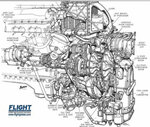Shortround6
Lieutenant General
The improvement for "Hookerizing" a DB engine might be very slight.

the opening to the supercharger is pretty well unobstructed. there is going to be some piping with a 90 degree bend (or close) and that is it.
On a Merlin X engine.

the carb mount is made in one piece with the supercharger front cover and inlet. One can see the abrupt change in direction the airflow has to make and indeed one can imagine that not areas of the inlet to the supercharger (or the impeller) were handling the same airflow. In fact it is worse that this photo shows

Air from the carb has to flow up around the depression in the center of the housing to reach the upper area of the intake to the supercharger.
Back to the 109

Air intake to supercharger is well centered with little obstruction. Note mating hole in the cowl panel at the top of the picture.
There may have been a number of other differences between the DB superchargers and RR superchargers but the inlets of the DB superchargers don't appear to have the problems the early RR superchargers had.
the opening to the supercharger is pretty well unobstructed. there is going to be some piping with a 90 degree bend (or close) and that is it.
On a Merlin X engine.
the carb mount is made in one piece with the supercharger front cover and inlet. One can see the abrupt change in direction the airflow has to make and indeed one can imagine that not areas of the inlet to the supercharger (or the impeller) were handling the same airflow. In fact it is worse that this photo shows
Air from the carb has to flow up around the depression in the center of the housing to reach the upper area of the intake to the supercharger.
Back to the 109
Air intake to supercharger is well centered with little obstruction. Note mating hole in the cowl panel at the top of the picture.
There may have been a number of other differences between the DB superchargers and RR superchargers but the inlets of the DB superchargers don't appear to have the problems the early RR superchargers had.


